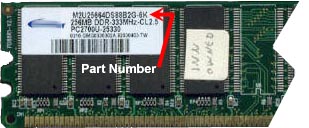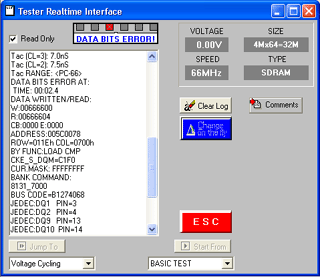Archives Discussions
- AMD Community
- Communities
- Developers
- Devgurus Archives
- Archives Discussions
- Re: I accidentally uninstalled the ATI Radeon Grap...
- Subscribe to RSS Feed
- Mark Topic as New
- Mark Topic as Read
- Float this Topic for Current User
- Bookmark
- Subscribe
- Mute
- Printer Friendly Page
- Mark as New
- Bookmark
- Subscribe
- Mute
- Subscribe to RSS Feed
- Permalink
- Report Inappropriate Content
I accidentally uninstalled the ATI Radeon Graphics from my Laptop. How can I fix it?
- Mark as New
- Bookmark
- Subscribe
- Mute
- Subscribe to RSS Feed
- Permalink
- Report Inappropriate Content
You can use the RAMCHECK memory tester for a variety of purposes. One of the most popular is to repair RAM. Repairing defective computer memory is a growing business, especially in developing countries where it is often more cost-effective to repair an old stick of memory than purchase a new one.
Of course, the first thing you need to do is test the suspect module to confirm that it is faulty. This takes just a few seconds with RAMCHECK.
If the module is OK, RAMCHECK will quickly identify the module's speed, size and type, and give a pass/fail message. If RAMCHECK has confirmed that the module is faulty, you will need to retrieve the data sheet from the manufacturer. This is easier than you may think, even for old modules.
First, find the manufacturer and the part number of the module. A small white label should be affixed to the module which includes the part number, and the manufacture r's name should be printed on the PCB (see figure A ). Next, go to the manufacturer's web site. (If you don't know what the URL is, type the company name into the search box at Google or Yahoo). Most manufacturers allow you to search by part number. If not, by selecting the right product categories you should be able to quickly navigate your way to the correct data sheet, which is typically a PDF file. Still not having luck finding it? Search for the part number on Google or Yahoo. The data sheets may no longer be linked from the company's web site, but the search engines may still have the link in their archives. If all else fails, you can use a continuity meter from the pin identified by RAMCHECK to find the connected chip.
r's name should be printed on the PCB (see figure A ). Next, go to the manufacturer's web site. (If you don't know what the URL is, type the company name into the search box at Google or Yahoo). Most manufacturers allow you to search by part number. If not, by selecting the right product categories you should be able to quickly navigate your way to the correct data sheet, which is typically a PDF file. Still not having luck finding it? Search for the part number on Google or Yahoo. The data sheets may no longer be linked from the company's web site, but the search engines may still have the link in their archives. If all else fails, you can use a continuity meter from the pin identified by RAMCHECK to find the connected chip.
![]() Once you have the datasheet, check RAMCHECK's display screen (see left). It will identify the relevant pins (circuit connections to the test socket) of the module which are associated with the problem. You can remove the module from the socket and review the Test Log. Easier still, use the RAMCHECK PC interface to identify faults (see below). Using this pin number and the module's layout from the data sheet, you can then trace the defect back to the faulty chip.
Once you have the datasheet, check RAMCHECK's display screen (see left). It will identify the relevant pins (circuit connections to the test socket) of the module which are associated with the problem. You can remove the module from the socket and review the Test Log. Easier still, use the RAMCHECK PC interface to identify faults (see below). Using this pin number and the module's layout from the data sheet, you can then trace the defect back to the faulty chip.

Now that you know where the defective chip is you'll have to replace it. Only a technician with component-level repair expertise can repair a memory module. The required soldering/ desoldering equipment is relatively complex, especially with modules and cards made with extremely thin Surface Mount technology (i.e., devices with TSOP  chips). You will need a good deal of practice with desoldering techniques. Nevertheless, a few minor problems, which are identified by RAMCHECK, can be repaired with simple tools. A short between an adjacent pin may be caused by a small piece of metallic debris, which is stuck between two chips. You "repair" the module in this case with an Exacto knife or a watchmaker's fine screwdriver by simply removing the debris. If you use RAMCHECK in the production shop, you should be able to easily replace the module's components.
chips). You will need a good deal of practice with desoldering techniques. Nevertheless, a few minor problems, which are identified by RAMCHECK, can be repaired with simple tools. A short between an adjacent pin may be caused by a small piece of metallic debris, which is stuck between two chips. You "repair" the module in this case with an Exacto knife or a watchmaker's fine screwdriver by simply removing the debris. If you use RAMCHECK in the production shop, you should be able to easily replace the module's components.
Repairing memory does involve a fair amount of work, but as companies around the world have discovered with RAMCHECK, it can be a lucrative business.
- Mark as New
- Bookmark
- Subscribe
- Mute
- Subscribe to RSS Feed
- Permalink
- Report Inappropriate Content
Everything seems to be running but I can’t see anything on the screen, not even a flashing cursor. The black screen in Windows has occurred before the Windows logo screen. The Sounds is still there. and I can still properly shut it down by just pressing the Alt+F4. Please someone help me.. ![]()
- Mark as New
- Bookmark
- Subscribe
- Mute
- Subscribe to RSS Feed
- Permalink
- Report Inappropriate Content
Oh man. That sounds scary. Hopefully, you've gotten a fix up and running. But just in case you need additional support, try contacting AMD Support here: http://emailcustomercare.amd.com/
- Mark as New
- Bookmark
- Subscribe
- Mute
- Subscribe to RSS Feed
- Permalink
- Report Inappropriate Content
You can use the RAMCHECK memory tester for a variety of purposes. One of the most popular is to repair RAM. Repairing defective computer memory is a growing business, especially in developing countries where it is often more cost-effective to repair an old stick of memory than purchase a new one.
Of course, the first thing you need to do is test the suspect module to confirm that it is faulty. This takes just a few seconds with RAMCHECK.
If the module is OK, RAMCHECK will quickly identify the module's speed, size and type, and give a pass/fail message. If RAMCHECK has confirmed that the module is faulty, you will need to retrieve the data sheet from the manufacturer. This is easier than you may think, even for old modules.
First, find the manufacturer and the part number of the module. A small white label should be affixed to the module which includes the part number, and the manufacture r's name should be printed on the PCB (see figure A ). Next, go to the manufacturer's web site. (If you don't know what the URL is, type the company name into the search box at Google or Yahoo). Most manufacturers allow you to search by part number. If not, by selecting the right product categories you should be able to quickly navigate your way to the correct data sheet, which is typically a PDF file. Still not having luck finding it? Search for the part number on Google or Yahoo. The data sheets may no longer be linked from the company's web site, but the search engines may still have the link in their archives. If all else fails, you can use a continuity meter from the pin identified by RAMCHECK to find the connected chip.
r's name should be printed on the PCB (see figure A ). Next, go to the manufacturer's web site. (If you don't know what the URL is, type the company name into the search box at Google or Yahoo). Most manufacturers allow you to search by part number. If not, by selecting the right product categories you should be able to quickly navigate your way to the correct data sheet, which is typically a PDF file. Still not having luck finding it? Search for the part number on Google or Yahoo. The data sheets may no longer be linked from the company's web site, but the search engines may still have the link in their archives. If all else fails, you can use a continuity meter from the pin identified by RAMCHECK to find the connected chip.
![]() Once you have the datasheet, check RAMCHECK's display screen (see left). It will identify the relevant pins (circuit connections to the test socket) of the module which are associated with the problem. You can remove the module from the socket and review the Test Log. Easier still, use the RAMCHECK PC interface to identify faults (see below). Using this pin number and the module's layout from the data sheet, you can then trace the defect back to the faulty chip.
Once you have the datasheet, check RAMCHECK's display screen (see left). It will identify the relevant pins (circuit connections to the test socket) of the module which are associated with the problem. You can remove the module from the socket and review the Test Log. Easier still, use the RAMCHECK PC interface to identify faults (see below). Using this pin number and the module's layout from the data sheet, you can then trace the defect back to the faulty chip.

Now that you know where the defective chip is you'll have to replace it. Only a technician with component-level repair expertise can repair a memory module. The required soldering/ desoldering equipment is relatively complex, especially with modules and cards made with extremely thin Surface Mount technology (i.e., devices with TSOP  chips). You will need a good deal of practice with desoldering techniques. Nevertheless, a few minor problems, which are identified by RAMCHECK, can be repaired with simple tools. A short between an adjacent pin may be caused by a small piece of metallic debris, which is stuck between two chips. You "repair" the module in this case with an Exacto knife or a watchmaker's fine screwdriver by simply removing the debris. If you use RAMCHECK in the production shop, you should be able to easily replace the module's components.
chips). You will need a good deal of practice with desoldering techniques. Nevertheless, a few minor problems, which are identified by RAMCHECK, can be repaired with simple tools. A short between an adjacent pin may be caused by a small piece of metallic debris, which is stuck between two chips. You "repair" the module in this case with an Exacto knife or a watchmaker's fine screwdriver by simply removing the debris. If you use RAMCHECK in the production shop, you should be able to easily replace the module's components.
Repairing memory does involve a fair amount of work, but as companies around the world have discovered with RAMCHECK, it can be a lucrative business.
- Mark as New
- Bookmark
- Subscribe
- Mute
- Subscribe to RSS Feed
- Permalink
- Report Inappropriate Content
Thanks Ian for your reply..it helps a lot
